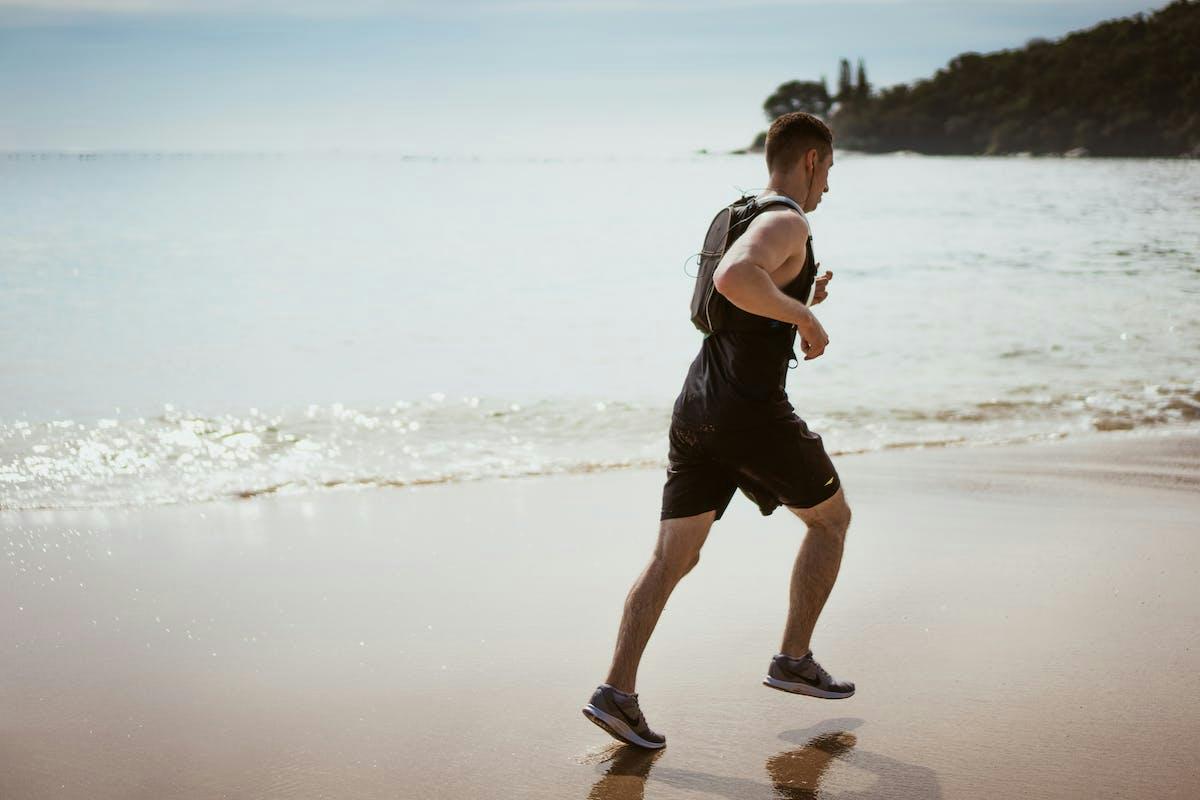Introduction
Running is more than the act of placing one foot in front of the other; it’s an art form that, when perfected, can take your fitness journey to new heights. In this guide, we’ll delve into the nuances of how to run properly, from understanding the basics to preventing common injuries. As you embrace these fundamentals, you’ll find yourself not just running but learning how to ‘run fast,’ mastering the art of efficient and speedy strides.
Understanding the Basics of Running
To become an efficient runner, mastering core elements like posture, head position, arm swing, shoulder alignment, and core engagement is essential. These fundamentals are vital to enhancing your running experience while minimizing injury risk. Incorporating a well-structured training plan can further support your journey. Moving forward, we’ll identify signs of poor technique and common pitfalls, ensuring a smoother and injury-resistant running experience.
Proper Running Form
When it comes to running for beginners, the devil is in the details. Your posture, head position, arm swing, shoulder position, torso, and core are crucial in efficient running.
Let’s break down each element to help you run like a pro.
Posture: Maintaining a straight and upright posture is fundamental. Steer clear of leaning forward or backward, as it may lead to muscle strain and impede your overall performance.
Head Position: Keep your head aligned with your spine, gaze straight ahead, and avoid looking down. This ensures proper alignment and minimizes strain on your neck and upper back.
Arm Swing: A controlled and coordinated arm swing contributes to your overall balance. Your arms should move naturally with your stride, swinging back and forth without excessive tension.
Shoulder Position: Relax your shoulders and keep them down. Tension in your shoulders can lead to discomfort and affect your overall form.
Torso and Core: Engage your core muscles to stabilize your torso. A strong core not only supports your spine but also enhances your overall running efficiency.
Stride Length: Find a comfortable stride length that suits your natural gait. Overstriding or taking too short steps can lead to inefficiencies and potential injuries.
Cadence: Maintain a consistent and comfortable cadence. Target approximately 180 steps per minute, as a higher cadence frequently results in improved energy distribution and less impact on joints.
Foot Strike: Land on your midfoot, avoiding striking with your heel or toes. This promotes a smoother and more efficient running motion.
Relaxation: Stay relaxed while running. Tension in your muscles can lead to fatigue and increase the risk of injuries.
Breathing: Develop a rhythmic breathing pattern. Inhale and exhale deeply, syncing your breath with your stride for optimal oxygen intake.
Signs of Poor Running Technique

Identifying signs of poor running technique is crucial for making necessary adjustments and avoiding potential injuries, especially during extended periods of time. Regardless of your fitness levels, understanding these warning signs is essential for a safer and more enjoyable running experience, ultimately helping you know how to get better at running and reducing the risk of injury.
Recurring Injuries or Muscle Soreness
If you’re experiencing consistent injuries or muscle soreness, it might be a sign that your running technique needs refinement.
Quick Fatigue and Shuffling
Feeling fatigued too quickly or adopting a shuffling gait could indicate inefficient energy distribution and poor form.
Making a Lot of Noise
Loud footfalls may suggest that your foot strike is too forceful, potentially leading to joint stress and injuries.
Unusual Arm/Leg/Foot/Head Movements
Any irregular movements in your limbs or head during running may signal imbalances or poor coordination.
Neck Pain
Neck pain is often a result of poor head position or overall misalignment during running.
Hunching Your Shoulders
Raised and tense shoulders can contribute to discomfort and hinder your running efficiency.
Overstriding
Taking excessively long strides may lead to overstriding, increasing the impact on your joints and risking injuries.
Stepping Too Hard
A heavy and forceful foot strike can strain your legs and feet, contributing to fatigue and potential injuries.
Not Controlling Your Arms
If your arms are swinging erratically or tensely, it may affect your overall balance and running efficiency.
Common Running Injuries
While running has numerous health benefits, being aware of potential injuries is essential.
Shin Splints: Shin splints, characterized by pain along the shinbone, are often a result of overuse or improper running technique.
Runner’s Knee: Runner’s knee is a common ailment, causing pain around the kneecap, often due to overtraining or poor form.
IT Band Syndrome: Iliotibial (IT) band syndrome can lead to outer knee pain and is frequently associated with tightness or imbalance.
Plantar Fasciitis: Inflammation affecting the tissue on the underside of the foot, known as plantar fasciitis, is commonly associated with inappropriate footwear or running technique.
Achilles Tendinitis: Achilles tendinitis entails inflammation of the Achilles tendon and can arise from overuse or abrupt increases in physical activity.
Stress Fractures: Stress fractures are minuscule cracks in the bones, frequently caused by repetitive stress, excessive training, or improper footwear.”
Ankle Sprains: Ankle sprains can happen when the ankle is rolled or twisted, often a result of uneven terrain or poor running surface.
Blisters: Friction between the skin and footwear can cause blisters, impacting your running comfort.
Muscle Strains: Overexertion or insufficient warm-up can lead to muscle strains, affecting various muscle groups.
Runner’s Toe: Black toenails or other toe-related issues are common among runners and may result from repetitive stress on the toes.
Injury Prevention Strategies

Now that we’ve covered the essentials and potential risks associated with running let’s delve into effective strategies inspired by reputable sources like Better Health Victoria to help you keep injuries at bay.
Warm-up and Cool-down: Initiate your session with a thorough warm-up and conclude with a cool-down to ready your muscles, facilitate recovery, track your heart rate for peak performance, and encourage a complete range of motion.
Gradual Progression: Gradually increase your running intensity and mileage to prevent overuse injuries, following the advice from Runkeeper. This method enables your body to adjust, minimizing the likelihood of strains and guaranteeing a running routine that is both sustainable and resistant to injuries.
Proper Footwear: Choose a high-quality pair of running shoes that provides ample support and suits the shape of your foot, ensuring comfort and proper alignment when your foot lands, regardless of your level of fitness
Strength Training: Incorporate strength training routines to develop muscles and enhance overall stability, benefiting distance runners and addressing the entire body within their comprehensive training program.
Cross-training: Diversify your exercise routine by incorporating activities such as swimming or cycling, a recommendation often emphasized by running coaches, to minimize the repetitive impact on your body.
Rest and Recovery: Explore a variety of exercises like swimming or cycling, a recommendation often emphasized by running coaches, to minimize the repetitive impact on your body. Additionally, incorporate interval training for enhanced cardiovascular fitness and performance.
Listen to Your Body: Listen to your body during your run; if you feel fatigue or discomfort, consider taking a break or seeking professional advice. This fundamental guideline from UConn Health underscores the importance of tuning into your body’s signals.
Flexibility and Mobility: Incorporate stretching and mobility exercises into your routine to enhance flexibility and prevent muscle imbalances, crucial aspects of a well-rounded aerobic exercise regimen.
Conclusion
Running is an excellent method to maintain fitness, yet achieving mastery in this art demands meticulous attention to detail and continual improvement As you delve into understanding proper form, recognizing signs of poor technique, and being aware of potential injuries, you pave the way for a confident run. By implementing preventive strategies and incorporating the guidance of Run Potential PT, a specialized approach to personal training, you not only minimize the risk of setbacks but also unlock your full running potential, ensuring a healthier and more fulfilling fitness journey.
Ready to take your running to the next level? Consider partnering with Up And Running PT for personalized training plan that caters to your unique needs. Your journey to becoming a better runner starts here!
FAQs
Q1: How do you run and stay injury-free?
A1: Running with proper form, listening to your body, and incorporating injury prevention strategies like strength training and cross-training can help you stay injury-free.
Q2: Why do I keep getting injured running?
A2: Frequent injuries may result from poor running technique, overtraining, inadequate rest, or improper footwear. Assess your form and training routine to identify potential issues.
Q3: How often should you run to avoid injury?
A3: The frequency of running differs for each individual. Pay attention to your body, include rest days, and gradually intensify your routine to reduce the risk of injury.


